If you haven’t heard, about a week ago, Childish Gambino, AKA multi-talented musical artist, screenwriter, actor, and comedian Donald Glover, released a new single called “This is America,” along with a shocking video that left people with one question… what does it all mean?
There are countless think-pieces, listicals, and Reddit threads trying to decode the video that try to break down every little detail, from clothing choices to background activity. While its true that “This is America” is masterful in its delivery, I think we are getting too wrapped up in the metaphors, imagery, and references– and forgetting about the message that the video sends: that there is a dangerous bifurcation in the stereotype that the white man has created for Black men. The Black man is either a cheerful servant to white culture and society, or a dangerous and violent criminal.
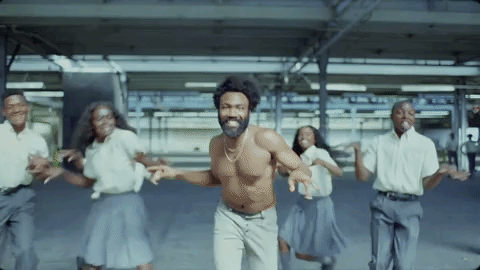
The Cheerful Servant
“This is America” begins with a happy, almost manic harmony over which Glover sings, “We just wanna party/party just for you.” In the video, a man sits on a chair and starts playing guitar and singing these lines as the camera pans over to Glover, who dances as he makes exaggerated faces. These faces which toe the line between smiles and grimaces recall images of minstrel and Blackface shows, which portrayed Black men as happy servants who were uneducated and childish, and therefore benefitted from their servitude to white people.
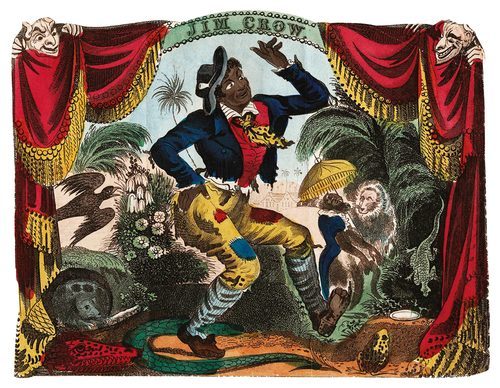
About a year ago, when I got my tattoo, the artist and I talked a bit about music. I asked him what he was listening to recently, and, surprisingly, he said, “Mumble rap.” This is music features heavy beats, often incomprehensible lyrics punctuated by “skrrrr” and “brap,” much like the second half of “This is America.” In response, I told him how much I loved Kendrick Lamar’s DAMN. He said, “Yeah, I liked Kendrick a lot, but it got lost on me when he started talking about Black power.”
Much like when Colin Kaepernick took the knee, white people become angry and dismissive once a major star of Color starts talking openly about race politics. The idea that these people are meant to entertain and not to express their views is problematic. It means that we look at people of Color as people who should use their creative talents to make something that white society can easily consume. The truth is, however, entertainers are people, and they have the right to express their views however they like, in their creative work or otherwise. Also, as I’ve continued to listen to music by POC, it has helped me to understand Black Lives Matter from a variety of personal perspectives, much like reading post-colonial literature in college helped me to understand how racism in America– which has not died out with neither the abolition of slavery nor desegregation– affected POC through history and today.
As the camera follows the dancing Glover back to the guitar playing man, we find that his head has been covered by a burlap sack. Glover pulls out a gun and shoots him violently. Upon the gunshot, the song then transitions to the darker beats and rap music.
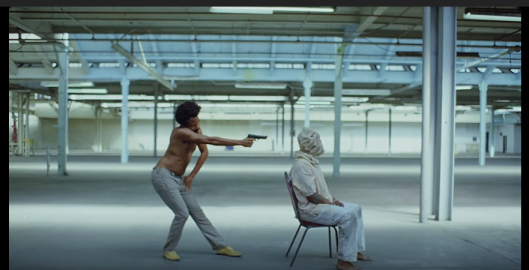
The Violent Criminal
Immediately when a Black man becomes disobedient, whether this disobedience is peaceful or not, whether this disobedience is legal or not, they become a dangerous and violent criminal. This is why Glover’s persona in the video commits these crimes.
The second the music switches from bright gospel vocals to deep, pulsing hip hop is when Glover becomes violent. The lyrics also become more deadpan and matter of fact: “This is America/Don’t catch you slippin’ up.” Not only does Glover become violent, but he expresses his own views and opinions outright, rather than “partying just for” us. The instant change in his character and his music highlight the contrast between these two personas and the dangerous balancing act that Black men must perform in order to survive.
Okay, so it’s true that there are gray areas here. What about rappers who promote violence in their music? Are they criminals? Sure, like other celebrities (and people in general), some commit their fair share of misdeeds, but as long as they keep quiet about race politics and keep making good music (regardless of what the lyrics may or may not promote), white America continues to consume the music they make. As long as Black people are contributing to our culture without expressing deep thought, especially about race politics, white people are quite happy.
On the other hand, think of all of the bodies that have piled up just because a Black man didn’t do exactly as he was told by the police. Or when Trayvon Martin was killed for wearing a hoodie and reaching into his pocket. Or when Eric Garner was killed for selling cigarettes illegally. Or when Philando Castille was killed in front of his girlfriend and her daughter at a traffic stop for telling the officer that he had a firearm. Have you ever heard of a white man or boy dying for any of these crimes?
In the video, Glover is the hyper-masculinized villain with assault rifles. He is the criminal, and the murderer. This being said, t all of his victims in the video, from the guitarist in the burlap sack to the singing choir, are also Black. When he is finished shooting, the guns are taken away from Glover by other people, carefully handled on a red silk cloth. The bodies of Glover’s victims, however, are battered, beaten, and dragged away, or, in other words, disposable. This creates a strong metaphoric message: Black people are worth less to America than firearms.
Ironically enough, the crimes that Glover commits– from lynching to slaughtering several Black people– are crimes that were historically committed by white people TO Black people. Therefore, Glover is only embodying the stereotype that has been given to Black men, as white people are quick to defend themselves by citing Black on Black violence. This stereotype makes it easy for white people, as a group, to deflect blame for the violence that racism continues to cause at the expense of Black lives.
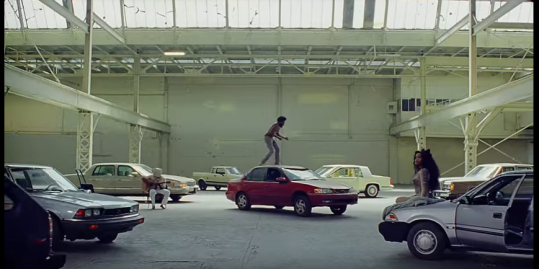
Everybody Else
Aside from this persona that Glover embodies and his victims, the other characters in the video are current Black celebrities (anyone catch SZA chilling on the car?), Black people who clean up Glover’s messes, and Black schoolchildren. Oh, and I think there are a few white people here and there, but they are mostly just blurry members of a mob that seems to be beckoned by Glover’s acts of violence.
Glover’s victims are all killed, ironically, as they are making music. Though they are contributing to the song that Glover is dancing to, they are still disposable and replaceable. Glover’s victims in the choir, however, brought a haunting memory to my mind. It reminded me of a night when I was told to be careful because there was a shooting behind my house. It was a night that I was told that nine people were killed just yards from where I lived. I discovered more details later. That all of the people killed were Black. That the shooter was, not only white, but a white supremacist. That the victims had welcomed this white shooter into their church to worship with them. That the church had a history of being a haven for southern Black Christians. These people were killed for nothing more than being Black.
The Black celebrities, the Black servants, and the Black schoolchildren, however, remain untouched. This is because they are contributing to society by either cleaning up messes and doing as they are told or creating popular and commercially successful music. The schoolchildren, however, retain their innocence and remain unharmed as they follow Glover through the video. This is because Black youth look up to stars such as Glover and SZA, celebrating a boom of Black representation in the media, but they are also blissfully ignorant of the more violent threats to Black people in America.
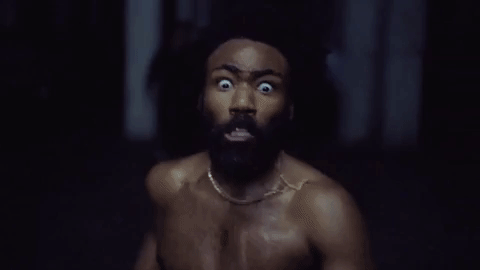
The Final Shot
As the song’s beat winds down, the camera zooms out from Glover dancing a top a car. The dark doorway through which the camera backtracks serves as a frame, which contains the narrative we just saw to just that- a frame, as if the whole thing were just a dream in Glover’s head. We leave this dream (or nightmare) as the camera flips over and reveals the same building, abandoned and dark, and a terrified Glover running away.
Glover sings:
You just a Black man in this world
You just a barcode, ayy
You just a Black man in this world
Drivin’ expensive foreigns, ayy
You just a big dawg, yeah
I kenneled him in the backyard
No proper life to a dog
For a big dog
These lyrics show what a Black man has been reduced to: a barcode, a product, an animal confined to the metaphorical cage (or literal cage when you account for the fact that Black men make up for 37 percent of 2.2 million incarcerated men) that we have locked him in because of the reductive stereotypes that we have created for the Black man.
“This is America” concludes with show one last shot of Glover, running through the building, which is now dark and abandoned, from the blurry mob, which contains the only white actors in the entire video.
The camera doesn’t focus on the mob, though. It focuses on Glover’s face, which is strained in absolute fear. The Black man, then, is not something to be feared. He is neither a vicious criminal nor a cheerful servant, but he is a man caught dangerously between these two stereotypes. He is a man who sees people like him so easily disposed of, and is afraid of being hurt, or worse, killed, for nothing else but the color of their skin.